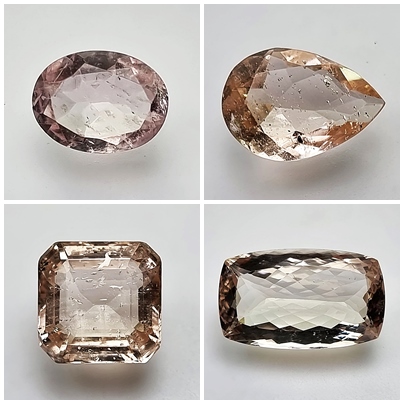
Morganite: capturing hearts with its gentle pink glow.
Morganite is the pink variety of the Beryl Family of minerals that also includes Aquamarine (blue), Bixbite (red), Emerald (green), Goshenite (colorless), Heliodor (yellow) and Pezzottaite (reddish pink). Morganite gets its pink-peach color from traces of manganese added to the basic Beryl formula. Like Aquamarine, large Morganite crystals have been found. Gems of several hundred carats have been cut from large crystals found in Brazil.
Morganite is known from several sources worldwide but the best sources of gemmy crystals are Konar and Laghman Provinces, Afghanistan; Minas Gerais, Southeast Region, Brazil; and in the USA at the Elizabeth R. Mine, Chief Mountain, Pala District, San Diego County, California, USA.
Discover the Sublime Beauty and Healing Properties of Morganite at Gemfame.com
Morganite, with its gentle pink to peach hues, captivates hearts with its ethereal beauty and metaphysical properties. Belonging to the beryl family, Morganite shares its lineage with renowned gemstones like emerald and aquamarine. Here at Gemfame.com, we delve into the allure and benefits of Morganite, making it a gemstone of choice for jewelry aficionados and spiritual seekers alike.
The Allure of Morganite: Morganite’s delicate pastel colors exude a sense of femininity and grace, making it a coveted gemstone for both classic and contemporary jewelry designs. Its subtle hues complement various skin tones and outfits, adding a touch of elegance and romance to any ensemble. Whether set in engagement rings, earrings, necklaces, or bracelets, Morganite’s timeless beauty captivates admirers and wearers alike.
Healing Properties of Morganite: Beyond its aesthetic appeal, Morganite is revered for its metaphysical properties and healing energies. Associated with the heart chakra, Morganite is believed to resonate with the essence of love, compassion, and emotional healing. It is often used to soothe anxiety, stress, and emotional trauma, fostering a sense of calm and inner peace. By opening the heart to love and forgiveness, Morganite encourages profound emotional healing and spiritual growth.
Benefits of Morganite:
- Emotional Healing: Morganite’s gentle energy helps release past wounds and emotional baggage, promoting healing and renewal. It encourages self-love, compassion, and empathy, fostering healthier relationships and emotional well-being.
- Spiritual Growth: By activating the heart chakra, Morganite facilitates spiritual growth, inner wisdom, and higher consciousness. It enhances intuition and connection with the divine, guiding individuals on their spiritual journey towards enlightenment and fulfillment.
- Physical Well-being: In addition to its emotional and spiritual benefits, Morganite is believed to have physical healing properties. It is thought to alleviate stress-related ailments, soothe the nervous system, and promote overall vitality and well-being.
Conclusion: At Gemfame.com, we celebrate the exquisite beauty and profound healing properties of Morganite. Whether you’re drawn to its soft hues or its metaphysical energies, Morganite is a gemstone that uplifts the spirit and nourishes the soul. Explore our collection of Morganite gemstones and jewelry to experience the sublime allure of this cherished gemstone firsthand.




